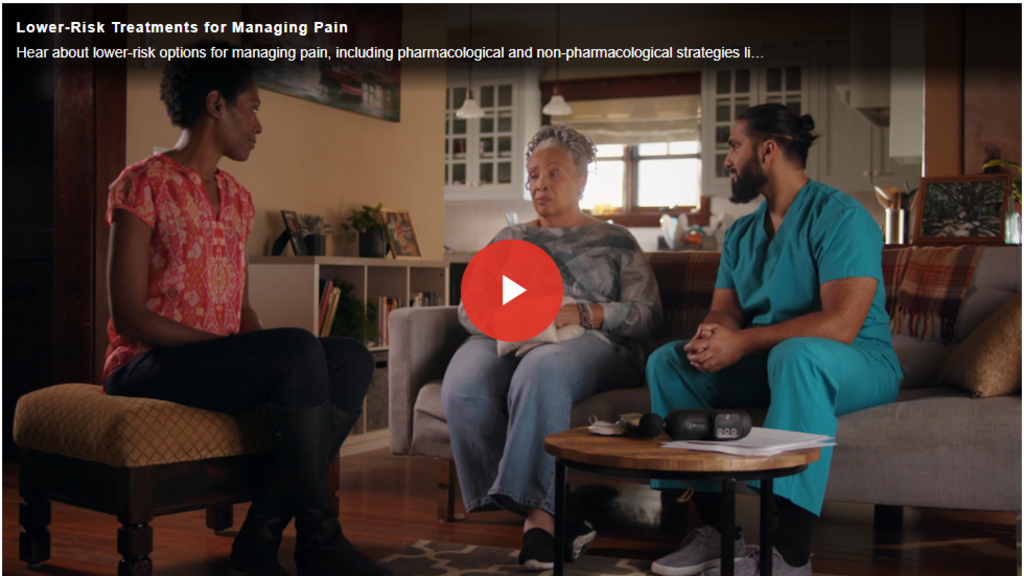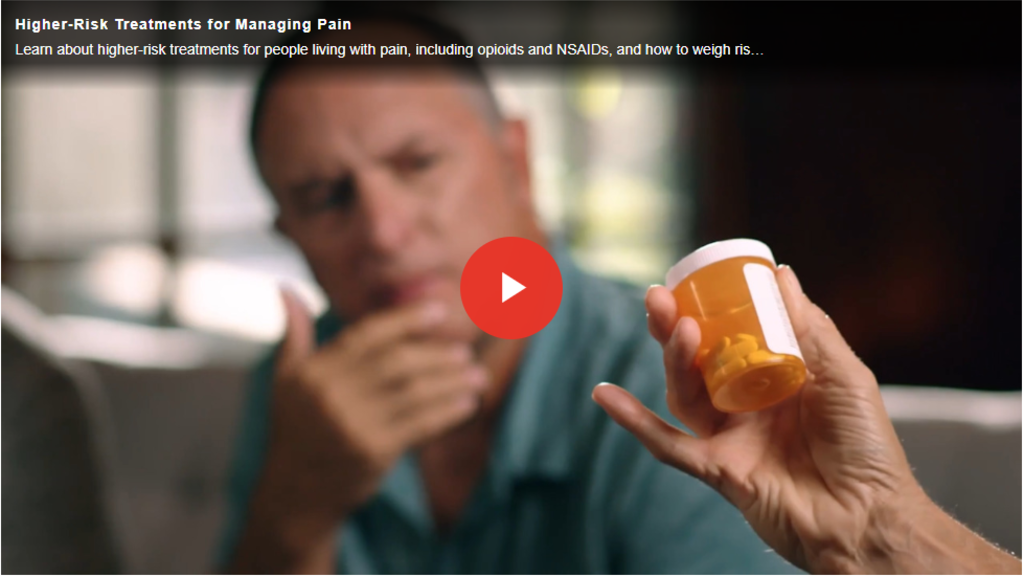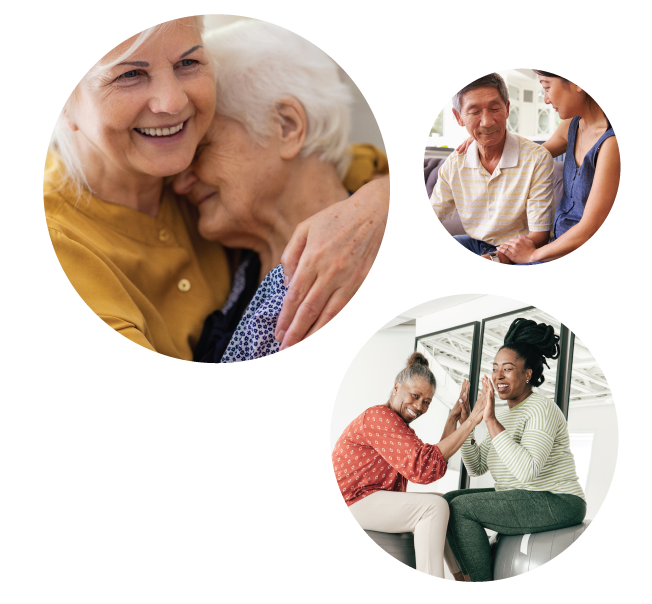
Pain Management Information
The information in this section provides family caregivers with knowledge in the form of “Fast Facts” (documents that provide a brief overview and details about a specific subject) that review topics such as An Overview of Nondrug Pain and Symptom Management; specific non-drug pain management techniques; Safety Precautions for Opioid Use; Opioid Side Effects, and Bowel Management for Opioid Use.
*New Video Resources*

Lower-Risk Treatments for Managing Pain
There is a range of lower-risk approaches for pain management, including pharmacological and non-pharmacological strategies. Hear about options for family caregivers and persons in pain to consider, including non-opioid analgesics and sleep hygiene, physical activity, meditation/guided imagery, and heat and cold as alternatives.

Higher-Risk Treatments for Managing Pain
Hear about higher-risk treatments for people living with pain, such as opioids and NSAIDs. The goals of the person in pain and the benefits and risks of medication are important considerations. Explore side effects and safety issues and get guidance in decision making and securing medications safely.
The videos are housed on the AARP website and were developed in partnership with Home Alone Alliance and Betty Moore Family Caregiving Institute.
Low-Risk Pain Treatments: Benefits, Risks, and Tips
Information on low-risk pain treatments, including benefits/risks and tips, on behavioral therapies, restorative therapies, complementary alternatives/integrative therapies, and low-risk medications.
Higher-Risk Pain Treatments: Benefits, Risks, and Tips
Information on higher-risk pain treatments, including summary of risks, use and monitoring tips, and the benefits of common drugs.
Non-Drug Related Interventions
Non-Drug interventions are treatments such as those listed below that can help maintain an older adult's quality of life and assist in pain management without the use of medications or in combination with medications.

Nondrug Pain and Symptom Management
- “Nondrug Pain and Symptom Management” provides an overview of the basics of Nondrug Pain Treatment Techniques. Shares some examples of different types of nondrug treatments, describes the general advantages and possible disadvantages and describes what a caregiver can do to assist their loved one with these types of treatments.
*NEW* Acupuncture
- Acupuncture” provides a general overview of acupuncture and provides guidelines for its use, tips about what to expect, and other things the family caregiver can do to assist.
*NEW* BioFeedback
- “BioFeedback” provides information about key points related to biofeedback training and several pain-related conditions that can be reduced by biofeedback.
- Cold Therapy
- “Cold as a Nondrug Pain Treatment” provides a general overview of cold treatments and provides guidelines for its use, describes types of equipment needed, direction on how to use this treatment and other things the family caregiver can do to assist.
Controlled Breathing & Guided Imagery
- “Controlled Breathing & Guided Imagery as a Nondrug Pain Treatment” provides a general overview of controlled breathing and guided imagery, detailed directions on how to use these techniques and other things the family caregiver can do to assist.
Distraction
- “Distraction as a Nondrug Pain Treatment” provides a general overview of the use of distraction the benefits, potential problems, methods to use, and other things the family caregiver can do to assist.
Exercise
- “Exercise as a Nondrug Pain Treatment” provides a general overview of the use of exercise including how it works to assist with pain control, different types of exercise one might try, and other things the family caregiver can do to assist.
Heat Therapy
- “Heat as a Nondrug Pain Treatment” provides a general overview of the use of heat to assist with pain control including heat treatment options, application guidelines (Dos and Don’ts), equipment needed, directions on use, and other things the family caregiver can do to assist.
Massage
- “Massage as a Nondrug Pain Treatment” provides a general overview of the use of massage to assist with pain control including application guidelines (both Dos and Don’ts), equipment needed, directions on use, and other things the family caregiver can do to assist.
Music
- “Music as a Nondrug Pain Treatment” provides a general overview of the use of music to assist with pain control including tips on use, what research suggests about the use of music, and what the family caregiver can do to assist.
*NEW* Physical Therapy/Occupational Therapy
- “Physical Therapy (PT) and Occupational Therapy (OT)” are types of rehabilitative care. PT focuses on restoring or improving movement, strength, and range of motion. OT aims to improve your family's motor skills to perform daily tasks.
Positioning
- “Positioning as a Nondrug Pain Treatment” provides a general overview of the use of positioning to assist with pain control including the benefits of positioning, guidelines, and what the family caregiver can do to assist.
Relaxation
- “Relaxation as a Nondrug Pain Treatment” provides a general overview of the use of positioning to assist with pain control including the benefits of relaxation, relaxation techniques, and what the family caregiver can do to assist.
*NEW* Tai chi
- ''Tai chi (pronounced TIE-CHEE), an ancient Chinese tradition, was originally developed for self-defense but has developed into a graceful form of exercise and can reduce pain through strengthening and improving flexibility and balance. Tai chi involves a series of slow, gentle, smooth movements.
*NEW* Yoga
- ''Yoga" provides a general overview of yoga, its benefits, as well as associated risks and precautions.
Drug Related Interventions
The documents in this section provide an overview of drug related interventions. Each provides a general overview of that topic, and specific information to assist the family caregiver to manage drug related issues for their loved one.
Bowel Management for Opioid Use
- “Bowel Management for Opioid Use” provides information about the issue of constipation that can occur with Opioid medication use to treat pain. The document provides the caregiver with important information to be aware of related to past medical history, lists possible bowel management treatments, and what the family caregiver can do to assist in managing.
Opioid Side Effects (Adverse Effects)
- “Opioid Side Effect (Adverse Effects)” provides general information about Opioid pain medication side effects, including common side effects and how to address each and what the family caregiver can do to assist in managing side effects of Opioid use.
Safety Precautions for Opioid Use with Older Adults
- "Safety Precautions for Opioid Use with Older Adults” provides information about key principles related to Opioid pain medication use with older adults, provides an overview of common opioid side effects (adverse effects) seen in older adults and what the family caregiver can do to assist if their loved one has been prescribed Opioid pain medications.
*NEW* Understanding the 2022 CDC Clinical Practice Guideline for Prescribing Opioids for Pain
- Clinical practice guidelines (often called “clinical guidelines”) are published statements that include recommendations on how to diagnose and/or treat a medical condition. While clinical guidelines are developed for the use of healthcare providers, they offer valuable information to patients and caregivers as well. Understanding the intent and guiding principles for implementation of these guidelines offer insight into the topics the healthcare provider should address with the patient and caregiver related to the use of opioids for pain control.
Webpage Last Revised 12.21.2023
